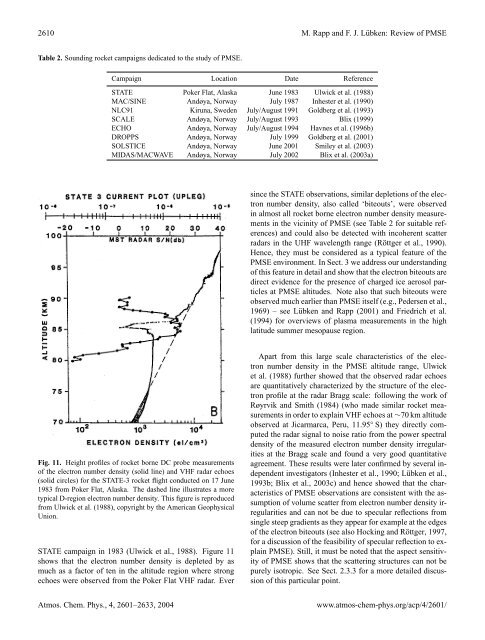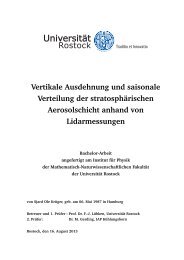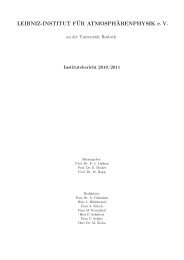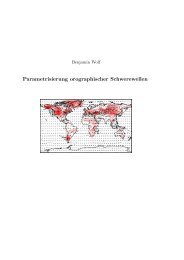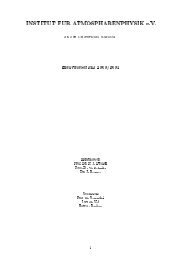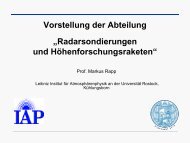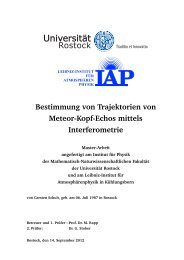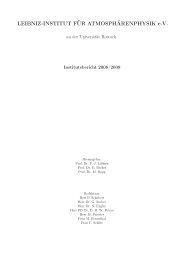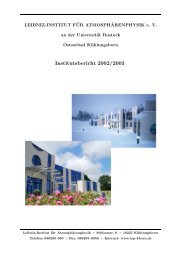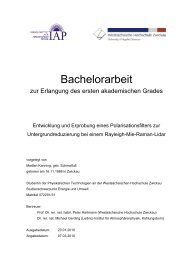Polar mesosphere summer echoes (PMSE): review of ... - HAL
Polar mesosphere summer echoes (PMSE): review of ... - HAL
Polar mesosphere summer echoes (PMSE): review of ... - HAL
You also want an ePaper? Increase the reach of your titles
YUMPU automatically turns print PDFs into web optimized ePapers that Google loves.
2610 M. Rapp and F. J. Lübken: Review <strong>of</strong> <strong>PMSE</strong><br />
Table 2. Sounding rocket campaigns dedicated to the study <strong>of</strong> <strong>PMSE</strong>.<br />
Campaign Location Date Reference<br />
STATE Poker Flat, Alaska June 1983 Ulwick et al. (1988)<br />
MAC/SINE Andøya, Norway July 1987 Inhester et al. (1990)<br />
NLC91 Kiruna, Sweden July/August 1991 Goldberg et al. (1993)<br />
SCALE Andøya, Norway July/August 1993 Blix (1999)<br />
ECHO Andøya, Norway July/August 1994 Havnes et al. (1996b)<br />
DROPPS Andøya, Norway July 1999 Goldberg et al. (2001)<br />
SOLSTICE Andøya, Norway June 2001 Smiley et al. (2003)<br />
MIDAS/MACWAVE Andøya, Norway July 2002 Blix et al. (2003a)<br />
since the STATE observations, similar depletions <strong>of</strong> the electron<br />
number density, also called ‘biteouts’, were observed<br />
in almost all rocket borne electron number density measurements<br />
in the vicinity <strong>of</strong> <strong>PMSE</strong> (see Table 2 for suitable references)<br />
and could also be detected with incoherent scatter<br />
radars in the UHF wavelength range (Röttger et al., 1990).<br />
Hence, they must be considered as a typical feature <strong>of</strong> the<br />
<strong>PMSE</strong> environment. In Sect. 3 we address our understanding<br />
<strong>of</strong> this feature in detail and show that the electron biteouts are<br />
direct evidence for the presence <strong>of</strong> charged ice aerosol particles<br />
at <strong>PMSE</strong> altitudes. Note also that such biteouts were<br />
observed much earlier than <strong>PMSE</strong> itself (e.g., Pedersen et al.,<br />
1969) – see Lübken and Rapp (2001) and Friedrich et al.<br />
(1994) for overviews <strong>of</strong> plasma measurements in the high<br />
latitude <strong>summer</strong> mesopause region.<br />
Fig. 11. Height pr<strong>of</strong>iles <strong>of</strong> rocket borne DC probe measurements<br />
<strong>of</strong> the electron number density (solid line) and VHF radar <strong>echoes</strong><br />
(solid circles) for the STATE-3 rocket flight conducted on 17 June<br />
1983 from Poker Flat, Alaska. The dashed line illustrates a more<br />
typical D-region electron number density. This figure is reproduced<br />
from Ulwick et al. (1988), copyright by the American Geophysical<br />
Union.<br />
STATE campaign in 1983 (Ulwick et al., 1988). Figure 11<br />
shows that the electron number density is depleted by as<br />
much as a factor <strong>of</strong> ten in the altitude region where strong<br />
<strong>echoes</strong> were observed from the Poker Flat VHF radar. Ever<br />
Apart from this large scale characteristics <strong>of</strong> the electron<br />
number density in the <strong>PMSE</strong> altitude range, Ulwick<br />
et al. (1988) further showed that the observed radar <strong>echoes</strong><br />
are quantitatively characterized by the structure <strong>of</strong> the electron<br />
pr<strong>of</strong>ile at the radar Bragg scale: following the work <strong>of</strong><br />
Røyrvik and Smith (1984) (who made similar rocket measurements<br />
in order to explain VHF <strong>echoes</strong> at ∼70 km altitude<br />
observed at Jicarmarca, Peru, 11.95 ◦ S) they directly computed<br />
the radar signal to noise ratio from the power spectral<br />
density <strong>of</strong> the measured electron number density irregularities<br />
at the Bragg scale and found a very good quantitative<br />
agreement. These results were later confirmed by several independent<br />
investigators (Inhester et al., 1990; Lübken et al.,<br />
1993b; Blix et al., 2003c) and hence showed that the characteristics<br />
<strong>of</strong> <strong>PMSE</strong> observations are consistent with the assumption<br />
<strong>of</strong> volume scatter from electron number density irregularities<br />
and can not be due to specular reflections from<br />
single steep gradients as they appear for example at the edges<br />
<strong>of</strong> the electron biteouts (see also Hocking and Röttger, 1997,<br />
for a discussion <strong>of</strong> the feasibility <strong>of</strong> specular reflection to explain<br />
<strong>PMSE</strong>). Still, it must be noted that the aspect sensitivity<br />
<strong>of</strong> <strong>PMSE</strong> shows that the scattering structures can not be<br />
purely isotropic. See Sect. 2.3.3 for a more detailed discussion<br />
<strong>of</strong> this particular point.<br />
Atmos. Chem. Phys., 4, 2601–2633, 2004<br />
www.atmos-chem-phys.org/acp/4/2601/


